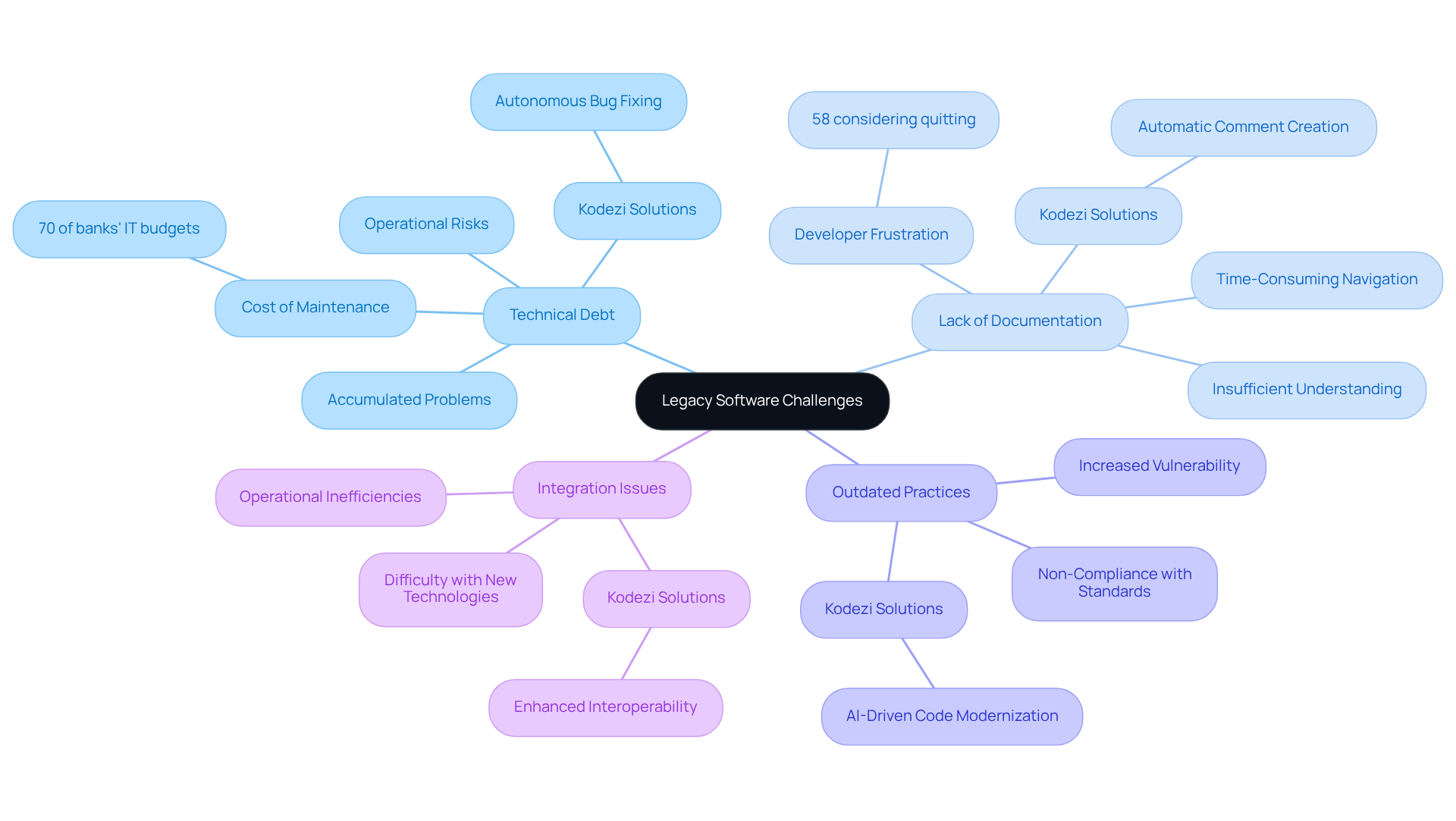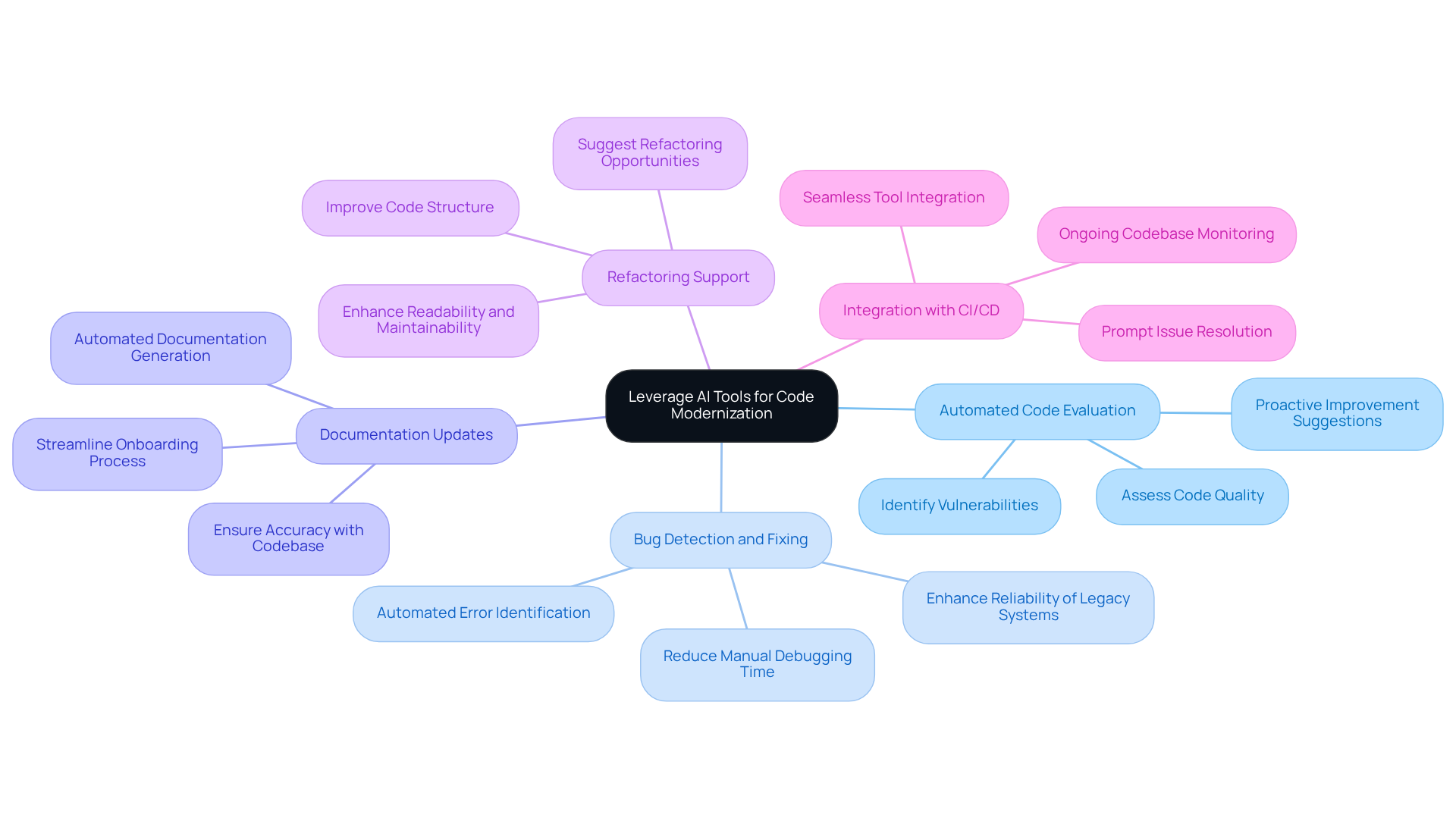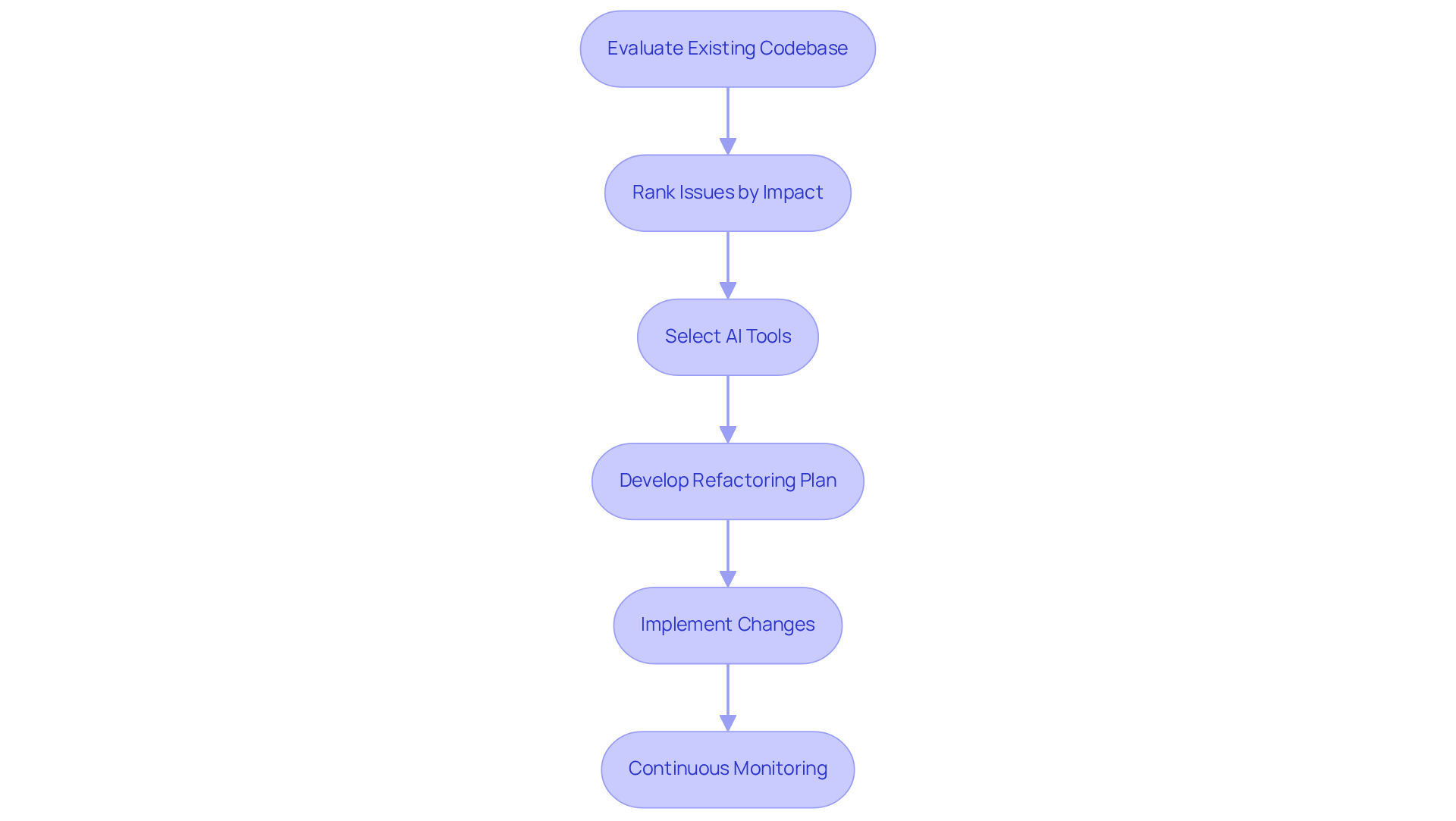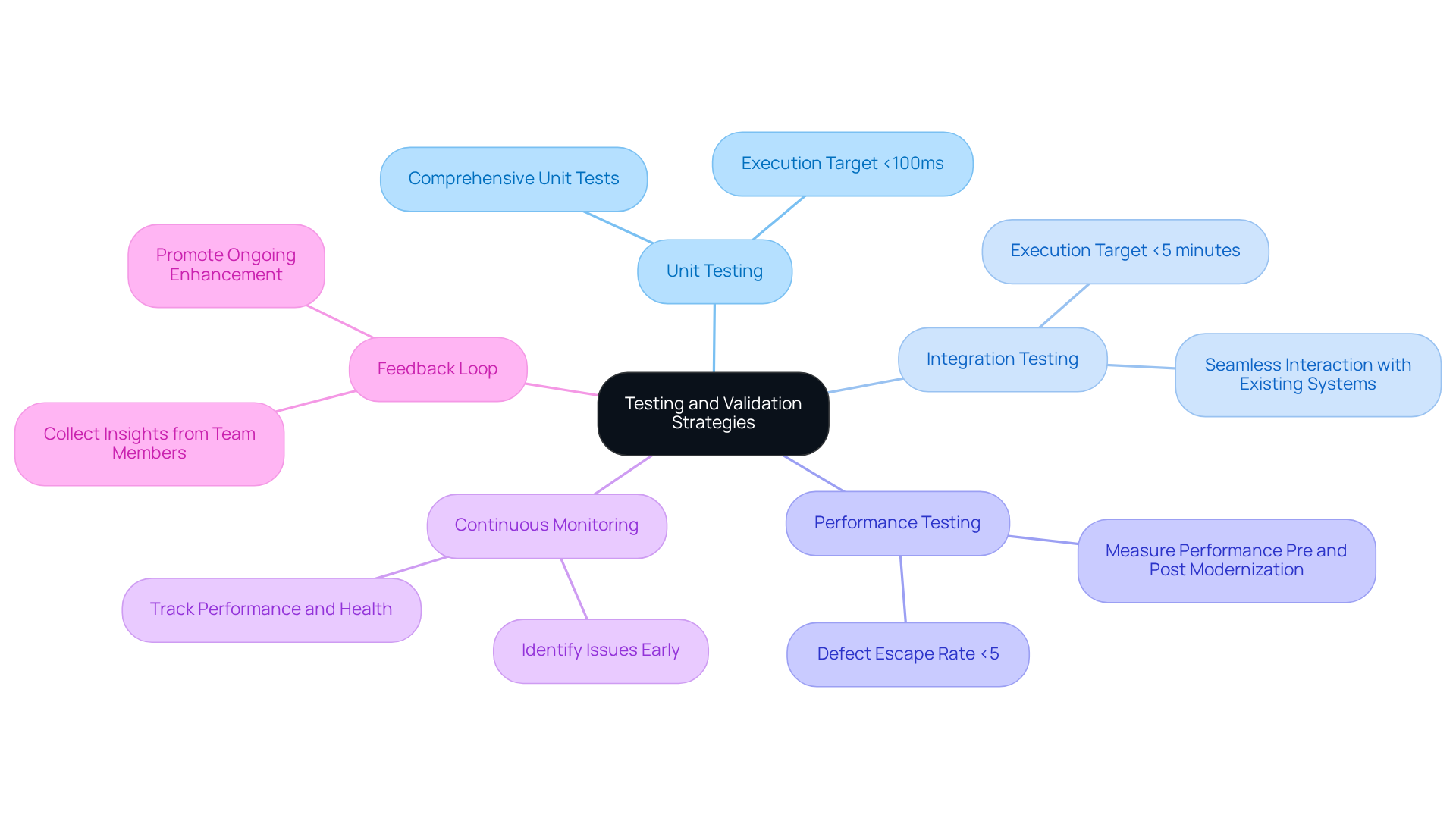Overview
In today's software development landscape, many developers face significant challenges with legacy code. Modernizing this code is crucial for maintaining efficiency and quality. This article outlines a step-by-step approach to leveraging AI in this process, starting with evaluating existing code. By utilizing AI tools, developers can enhance their codebases significantly.
Furthermore, addressing challenges such as technical debt and outdated practices is essential. AI solutions automate code evaluation, bug detection, and documentation updates, making these tasks more manageable. As a result, developers can focus on what truly matters: improving software quality and operational efficiency.
In addition, the benefits of integrating AI into the modernization process are substantial. By automating repetitive tasks, developers can enhance productivity and ensure higher code quality. This not only streamlines workflows but also reduces the risk of human error, leading to more reliable software.
Ultimately, embracing AI tools for legacy code modernization is a strategic move for developers. By exploring the available tools on platforms like Kodezi, developers can transform their coding practices and achieve remarkable improvements in their projects.
Introduction
Legacy code often presents a formidable challenge for organizations, encumbered by technical debt, outdated practices, and integration issues that can hinder innovation and efficiency. As the demand for modern software solutions escalates, the opportunity to leverage AI tools for code modernization becomes increasingly essential.
How can developers effectively navigate the complexities of transforming these systems while ensuring quality and performance?
This article explores a step-by-step approach to modernizing legacy code with AI, unlocking the potential for enhanced productivity and streamlined operations.
Understand Legacy Code and Its Challenges
Legacy software refers to outdated programming that remains in use, often created in older languages or frameworks. This situation presents several challenges that can significantly hinder development and maintenance efforts.
-
Technical Debt: One of the most pressing issues is technical debt, which describes the accumulated problems within the codebase that complicate maintenance and slow down development. Organizations relying on older systems frequently encounter heightened operational risks and inefficiencies. In fact, 70% of banks allocate most of their IT budgets to upkeep obsolete systems. Kodezi CLI can help mitigate this technical debt by autonomously analyzing and fixing bugs before they reach production, enabling organizations to address issues and cut costs.
-
Lack of Documentation: Another challenge is the lack of documentation. Insufficient or outdated documentation can lead to misunderstandings about the program's functionality, making it difficult for developers to navigate and modify the system effectively. Kodezi boosts programming efficiency by automatically creating comments and clarifications regarding the script. This enhancement can greatly decrease the time dedicated to resolving issues and managing outdated systems, reducing frustrations among developers—58% of whom are contemplating leaving due to insufficient outdated technology stacks.
-
Outdated Practices: Furthermore, legacy programming often does not comply with contemporary coding standards, rendering it less efficient and more vulnerable to bugs. Kodezi's AI-driven tool functions as an autocorrect for programming, enabling developers to modernize legacy code with ai by automatically enhancing and transforming outdated scripts to meet current standards. This capability is crucial for ensuring program reliability and operational efficiency as organizations adapt to new requirements. As Ammar Rizvi points out, "It is absolutely essential to highlight issues within code to the group, so that there can be a mutual understanding of problems and a collective proposal for solutions."
-
Integration Issues: Similarly, older systems frequently encounter difficulties when integrating with new technologies, which can hinder overall performance and limit the ability to leverage modern tools and frameworks. Kodezi CLI addresses these integration challenges by providing a seamless solution for B2B engineering teams, enhancing interoperability and allowing organizations to capitalize on advancements in technology. Additionally, Kodezi helps mitigate compliance risks associated with outdated regulatory updates, further simplifying the modernization process.
Acknowledging these challenges is the initial step toward efficiently modernizing legacy code with ai. Unlike applications such as Copilot, which concentrate on autocomplete, Kodezi functions as an autocorrect for programming, offering distinctive solutions designed to improve productivity. With support for over 30 programming languages and integration with Visual Studio Code, Kodezi's capabilities empower organizations to significantly enhance their operational capabilities.

Leverage AI Tools for Code Modernization
In the ever-evolving landscape of software development, outdated systems pose significant challenges for developers. How can AI applications help streamline this process? Here’s how leveraging these tools can transform your approach:
-
Automated Code Evaluation: AI systems conduct thorough assessments of existing codebases, identifying vulnerabilities, inefficiencies, and areas for improvement. This proactive strategy is crucial for maintaining quality and security, especially as software complexity increases.
-
Bug Detection and Fixing: By utilizing AI solutions for bug detection, teams can drastically cut down on the time spent on manual debugging. These tools automatically identify and rectify errors, enhancing the reliability of legacy systems and allowing teams to focus on more strategic initiatives.
-
Documentation Updates: Keeping documentation current is vital for effective program management. AI can automatically generate or update documentation, ensuring it accurately reflects the codebase’s state. This not only saves time but also streamlines onboarding for new team members.
-
Refactoring Support: AI tools can suggest refactoring opportunities, helping to enhance code structure and readability. By automating this process, teams can ensure their software remains maintainable and scalable, which is essential for long-term success.
-
Integration with CI/CD: For continuous improvement, seamless integration of AI tools with CI/CD pipelines is essential. This integration facilitates ongoing monitoring and enhancement of the codebase, ensuring that issues are addressed promptly and efficiently.
By incorporating these AI features, engineering teams can effectively modernize legacy code with AI, ultimately leading to improved software quality and reduced technical debt. Are you ready to explore how Kodezi can elevate your coding practices?

Implement a Step-by-Step Modernization Process
To modernize legacy code with AI effectively, developers often face significant challenges. A comprehensive evaluation of the existing codebase is essential to pinpoint areas needing modernization. This foundational step is crucial, as understanding the operational and technological challenges posed by legacy systems is vital for effective transformation.
Once issues are identified, ranking them based on their impact on performance and maintainability becomes necessary. Systems with higher scores are better candidates for modernization, allowing teams to focus on high-impact areas that minimize disruption to ongoing operations. Furthermore, selecting suitable AI tools that align with your goal to modernize legacy code with AI is key. For example, Kodezi CLI can independently enhance your programming repository and resolve issues before they enter production, ensuring compliance and readiness for deployment.
Next, developing a detailed refactoring plan outlines how to tackle the prioritized issues, including timelines and responsibilities. This plan should reflect a balance between risk, cost, and business value, ensuring that the modernization strategy fits the organization's needs. When executing changes, implementing the adjustments according to the plan, leveraging Kodezi CLI for bug detection and improvements, brings the practical application of your assessment and planning to fruition.
Continuous monitoring of the codebase for new issues is essential to verify that the changes yield the desired outcomes. Regular reviews against objectives help ensure alignment with project goals during modernization. Recognizing that modernization is an ongoing journey is crucial. Regularly revisiting the codebase to identify new areas for improvement and applying AI tools fosters a culture of continuous improvement, which is essential for maintaining a clean and compliant codebase.
By following this systematic approach, engineering teams can effectively modernize legacy code with AI, ensuring that their software remains robust and aligned with current technological standards. Why not explore the tools available on the Kodezi platform to enhance your coding practices today?

Ensure Quality Through Testing and Validation
To address the challenges developers face in ensuring high-quality code, it is essential to implement effective testing and validation strategies. Modernized code requires rigorous assessment to guarantee its functionality and performance. Here are key strategies that can significantly enhance code quality and deployment frequency:
- Unit Testing: Establish comprehensive unit tests for all new implementations and refactored sections to ensure functionality. Aiming for a unit test execution target of under 100 milliseconds can significantly enhance developer productivity and deployment frequency.
- Integration Testing: Conduct integration tests to verify that the modernized software interacts seamlessly with existing systems. With a target integration test suite execution time of under 5 minutes, teams can efficiently validate system compatibility.
- Performance Testing: Measure the performance of the program before and after modernization to quantify improvements. This includes assessing metrics such as defect escape rate, which should ideally be under 5%, to ensure that bugs are caught early in the development cycle.
- Continuous Monitoring: Utilize monitoring tools to track the performance and health of the codebase post-modernization. This ongoing assessment helps identify potential issues before they escalate, maintaining system integrity.
- Feedback Loop: Create a feedback loop with group members to collect insights on the program's performance and any issues that arise. This collaborative method promotes ongoing enhancement and guarantees that the modernization initiatives align with group objectives.
By prioritizing these testing and validation strategies, teams can confidently deploy solutions that modernize legacy code with AI, ensuring they meet quality standards and enhance overall system performance. Emphasizing integration testing is particularly crucial, as it ensures that all components work together effectively, ultimately leading to a more robust and reliable application. Have you considered how these strategies could improve your coding practices?

Conclusion
Modernizing legacy code with AI is not just a necessity; it is a strategic imperative for organizations aiming to enhance operational efficiency and maintain competitiveness in a rapidly evolving technological landscape. The challenges posed by outdated systems—such as technical debt, lack of documentation, outdated practices, and integration issues—underscore the importance of embracing innovative solutions like Kodezi. By leveraging AI tools, teams can effectively tackle these challenges, streamline their development processes, and ultimately transform their legacy systems into robust, modern applications.
Throughout this article, key strategies for successful modernization have been highlighted. From understanding the inherent challenges of legacy code to implementing a systematic approach for evaluation, prioritization, and execution, the path to modernization is clear. The integration of AI tools not only facilitates automated code evaluation and bug detection but also enhances documentation and refactoring efforts. Furthermore, rigorous testing and validation strategies ensure that the modernized code meets quality standards, reinforcing the need for a comprehensive approach to modernization.
As organizations continue to navigate the complexities of legacy systems, the importance of adopting AI-driven solutions cannot be overstated. Embracing these technologies fosters a culture of continuous improvement and positions teams to respond effectively to evolving business needs. By prioritizing modernization efforts, organizations can unlock significant benefits, reduce operational risks, and pave the way for future innovations. Now is the time to explore how AI tools can elevate coding practices and transform legacy systems into agile, efficient solutions that meet the demands of the modern digital landscape.
Frequently Asked Questions
What is legacy software?
Legacy software refers to outdated programming that remains in use, often created in older languages or frameworks, which can hinder development and maintenance efforts.
What is technical debt in the context of legacy code?
Technical debt describes the accumulated problems within the codebase that complicate maintenance and slow down development, leading to heightened operational risks and inefficiencies.
How does Kodezi CLI help with technical debt?
Kodezi CLI autonomously analyzes and fixes bugs before they reach production, enabling organizations to address issues and cut costs associated with technical debt.
What challenges arise from a lack of documentation in legacy systems?
Insufficient or outdated documentation can lead to misunderstandings about the program's functionality, making it difficult for developers to navigate and modify the system effectively.
How does Kodezi improve documentation for legacy code?
Kodezi boosts programming efficiency by automatically creating comments and clarifications regarding the script, reducing the time dedicated to resolving issues and managing outdated systems.
What are outdated practices in legacy programming?
Outdated practices refer to legacy programming that does not comply with contemporary coding standards, making it less efficient and more vulnerable to bugs.
How does Kodezi assist in modernizing legacy code?
Kodezi's AI-driven tool functions as an autocorrect for programming, automatically enhancing and transforming outdated scripts to meet current standards, ensuring program reliability and operational efficiency.
What integration issues do legacy systems face?
Older systems often encounter difficulties when integrating with new technologies, which can hinder overall performance and limit the ability to leverage modern tools and frameworks.
How does Kodezi address integration challenges?
Kodezi CLI provides a seamless solution for B2B engineering teams, enhancing interoperability and allowing organizations to capitalize on advancements in technology.
What makes Kodezi different from applications like Copilot?
Unlike applications such as Copilot, which focus on autocomplete, Kodezi functions as an autocorrect for programming, offering distinctive solutions designed to improve productivity.
What programming languages does Kodezi support?
Kodezi supports over 30 programming languages and integrates with Visual Studio Code, empowering organizations to enhance their operational capabilities.




